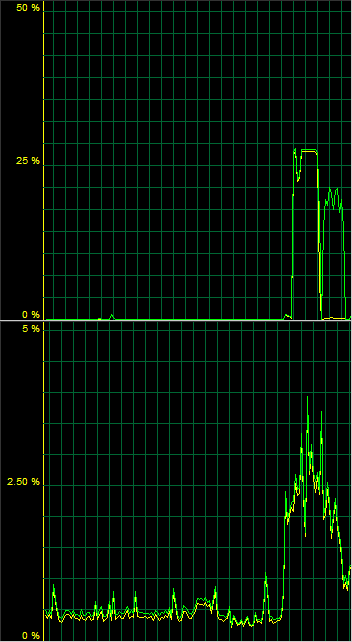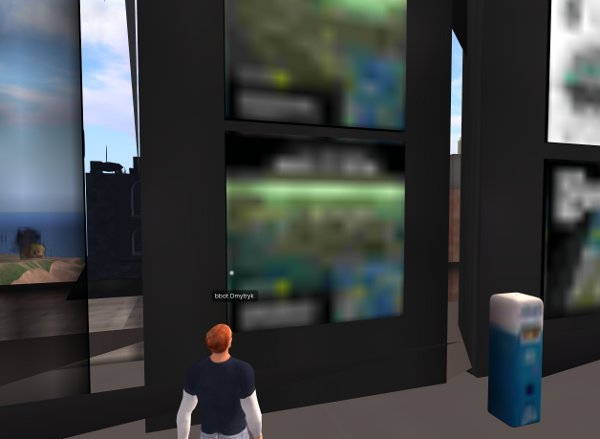Sun May 22 19:10:51 PDT 2011
the failure of second life
In July of 2005, when I created my account, Second Life was the cool new thing. Moving between regions was kinda wonky, loading textures and objects was slow, and it was pretty ugly when compared to other games of the time; but it was generally assumed that these were teething issues, which would be quickly sorted out as new versions of the software were released.
At the time, I used an Athlon XP 2500+ processor, a not enormously distinctioned graphics card, 768 megabytes of ram, and phat 2 megabit/512 kilobit DSL.
Today I have an Intel Core i7 940, an eight-threaded processor that can access 6 gigabytes of ram, and Radeon HD4860 video card with a further 512 megabytes of ram, and I have symmetrical 25 megabit fiber internet. The processor's an easy six times faster, there's eight times as much memory, the internet pipe is 12 times wider, and the video card is, well, it's real quick.
Moving between regions is still kinda wonky, loading textures and objects is slow, and it's still pretty ugly... when compared to games made in 2005. Second Life has gained features, many of them, but it has improved not at all. Its problems are profound and architectural, and won't be solved by any minor patch, but rather, a complete redesign. Something that won't happen, as even in its broken, half-assed state, it still makes rather a lot of money from furries, (like Zarla) and it takes quite the brave company indeed to break a profitable product to instead create something that may make no money at all.
And so, let us speak of architecture.

(Above: downloading a file from my ISP's datacenter at 25mbit/s. Below: Flying through Second Life with the draw distance set to 512 metres, and consuming so much bandwidth that the game disconnected me. My mark I eyeball figures that graph peaks at 4mbit/s.)
Go and grab a software engineer. There's plenty of them around, so it should be easy to find one. Tell her that she'll have to design a social MMO for a brand new console. This should make her eyes light up, because, as a rule, engineers prefer new technology over stuff that actually works, since new technology is cool and sexy, and old technology makes money.
Tell her that the new console is pretty much a stacked modern PC, with a dozen processor cores and heaps of memory. This will be well received. Then tell her, due to budget constraints, there's only four megabits of bandwidth between the processor and the disk drive, where all the game assets are.
Brace yourself. There will be swearing, threats to go back to Google, various and sundry recriminations. Placate her with twenty million dollars and two years later, go pick up your social MMO.
That game, a game designed with a major, major bandwidth limitation in mind, will be very careful to control player location. Maps will be linear, and areas of high detail will be strictly gated. Player movement will be slow. All this is done so that the game has time to load level geometry and textures into memory before the player gets there.
Second life allows the player to move at arbitrary speed (And height! Players can fly!) in an open world environment. There are no loading screens except during teleports. Players design the levels, and they can use all the huge textures and as many polys as they want. The majority of player-owned land is continental, where the tragedy of the commons is in full effect. Geometry pop-up is endemic. Textures can take a full minute to load. FPS on my stacked gaming computer is in the teens with any draw distance above "myopic". Performance is completely, absolutely unacceptable for an eight year old game!
Second Life as a game concept, sounds good, but was made with no thought of the fact that all the game assets are on the wrong side of a narrow, high-latency bus.
Second Life attempted to emulate Real Life in design. This was laudable, but misguided. Perhaps that's not the right word. Incorrect? Wrong? Colossally wrong?
It's been eight years, now, since Second Life launched. It hasn't come close to living up to its promise. My wild ass guess is that their asset servers will have sustain two hundred megabits a second to the customer in order to make Second Life even vaguely playable.[1] That's for SL's current, not great, graphics, nor a terribly inspiring draw distance, maybe 300 metres.
Not only would this require better internet service than pretty much anybody, outside of South Korea, has; it would take an absolutely massive investment in data centers all around the world. It only takes 40 megabits to stream high quality 1080p video. Sustaining five times that bandwidth, and maintaining consistency across all the caches would be a real trick.
I doubt Second Life will ever do it.
1: The PS3's drive can read a DVD at 8x speed, or 86mbit/s. (Blu-ray discs are actually slower, for some zany reason.) A top of the line solid state hard drive will do 4000 mbit/s.
